Most private colleges take very few transfers. At USC, about 1,500 get a spot each year
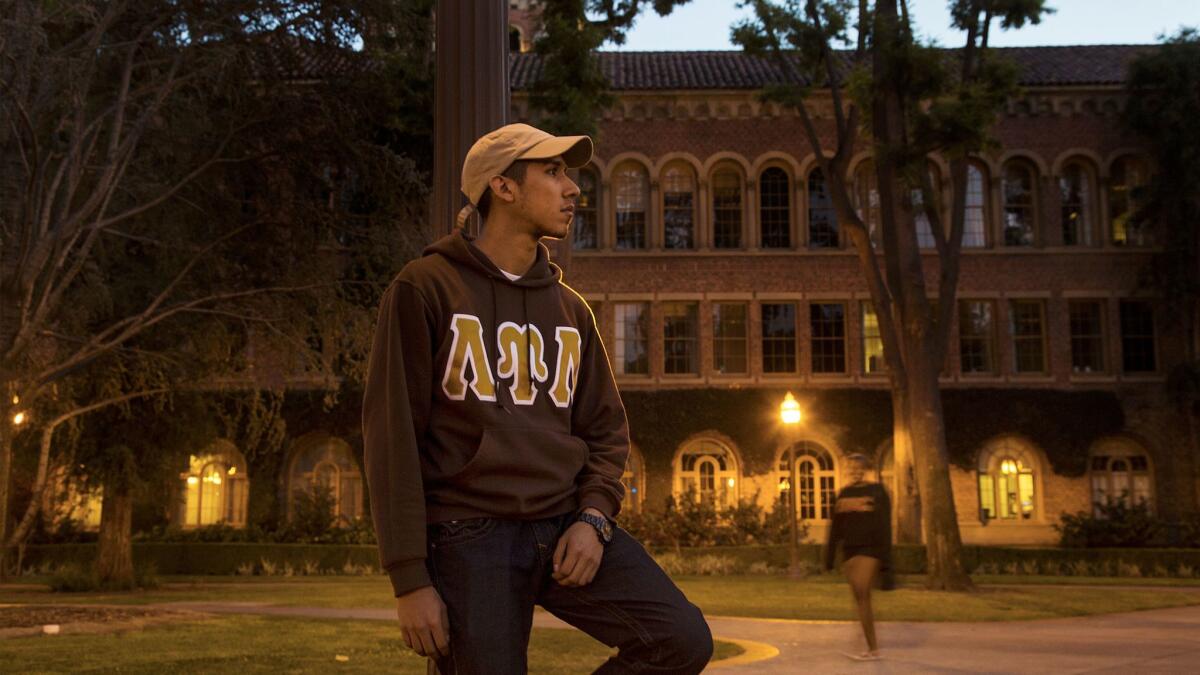
Xavier Garcia sat at a welcome dinner the evening of move-in day at USC, shoulders straight, shirt tucked, hands folded over a notebook filled with questions to ask and people to meet.
With Ds in high school and no family with college degrees, he once had dismissed the possibility of attending a private school. But at Sacramento City College, he had buckled down. Now here he was, a transfer student at the so-called University of Spoiled Children.
Transferring into an elite private college is not easy. Princeton hasn’t taken a transfer in more than two decades, according to the latest data from the National Center for Education Statistics. In the fall of 2015, Stanford enrolled 15 transfer students; Yale, 24. Cornell and Georgetown University, known for accepting transfers, took in 497 and 186, respectively.
USC, by contrast, accepted 1,505 transfers from 350 colleges. They made up almost one-third of its new undergraduates. About 800, like Garcia, transferred from a community college. Many were the first in their families to attend college. Most were on financial aid.
“When my mom told me she depended on me to give her a better life for our family, I was like, ‘OK, I will do something with my life,’” Garcia said. “I’m ready to prove myself.”
Beside him at the dinner, Garcia’s mother silently took in USC’s cardinal and gold tablecloths, the ballroom filled with eager students — her son’s new world. She squeezed his hand and burst into tears.
The number of transfers at USC is huge, especially when put in a national context, said Terry Hartle, senior vice president of the American Council on Education.
“In any given year, about 1.6 million students in the country will enroll for the first time as a community college student,” he said. “About 10% of those will transfer to another institution — so about 160,000. About 2% of those will go to a private university. So if USC alone enrolls 800, that’s 800 out of 3,200. … That’s really dramatic.”
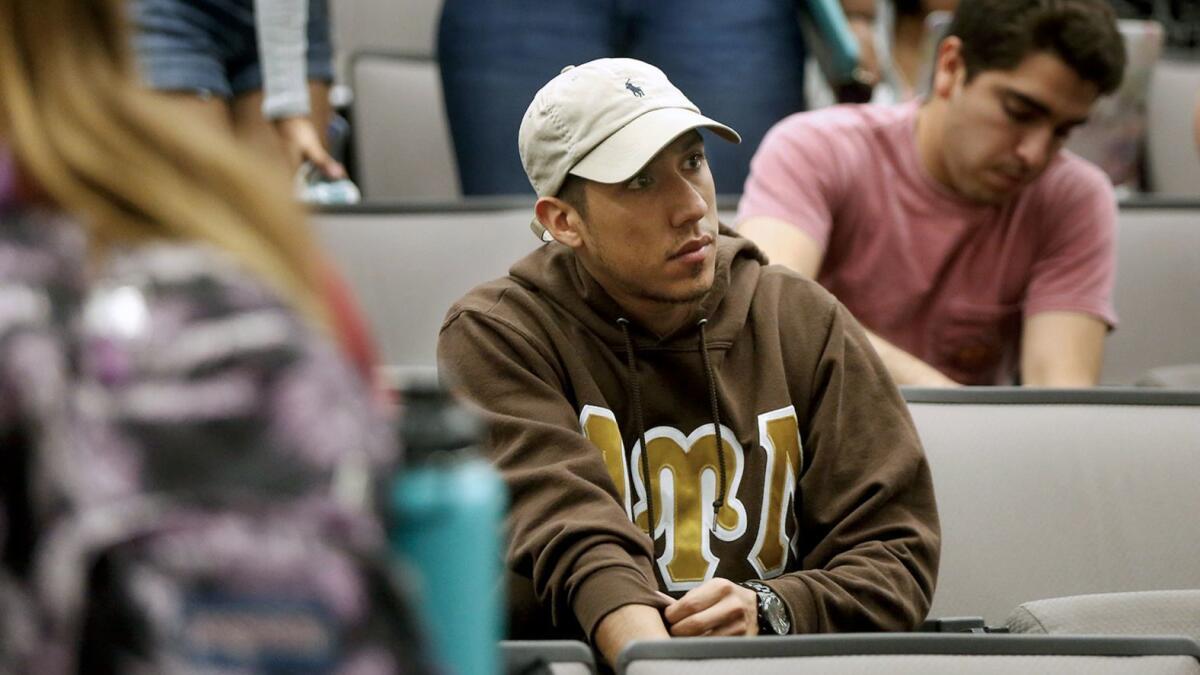
Recruiting and accepting a significant number of transfers has helped change the demographics of USC. The campus is no longer majority white; about 23% of undergraduates are eligible for Pell Grants, federal financial aid for low-income students.
Students in Garcia’s shoes often turn to the University of California or California State University — public schools with structured transfer programs, many relatable classmates and sticker prices much lower than USC’s, where the total cost per undergraduate is estimated to be $72,273 for the next academic year.
To make USC possible for many of these students, the university points to its financial aid and student support: Last year, the school spent more than $42 million providing grants to community-college transfers. It organizes question-and-answer sessions and “TransferMation” workshops including crash courses in library research, networking skills and “making the most of your summer.”
“It’s not necessarily easy, and it’s certainly not cheap, but nor is it rocket science,” Hartle said. “It’s one thing to get more students in. It’s another thing to get them in, get them through with an education and get them out the door with a degree in hand. So the schools that are going to be successful at it will be the schools that are willing to identify and recruit and admit transfer students — and provide an array of services to help them succeed.”
Garcia worked hard to find his way at USC. He got two scholarships. He asked a professor to lunch to figure out his major. He made one of the many student centers on campus a regular hangout.
When an advisor at the center noticed that he hadn’t come by in days, she emailed to make sure he was OK.
“People actually notice when you’re not here,” he said.
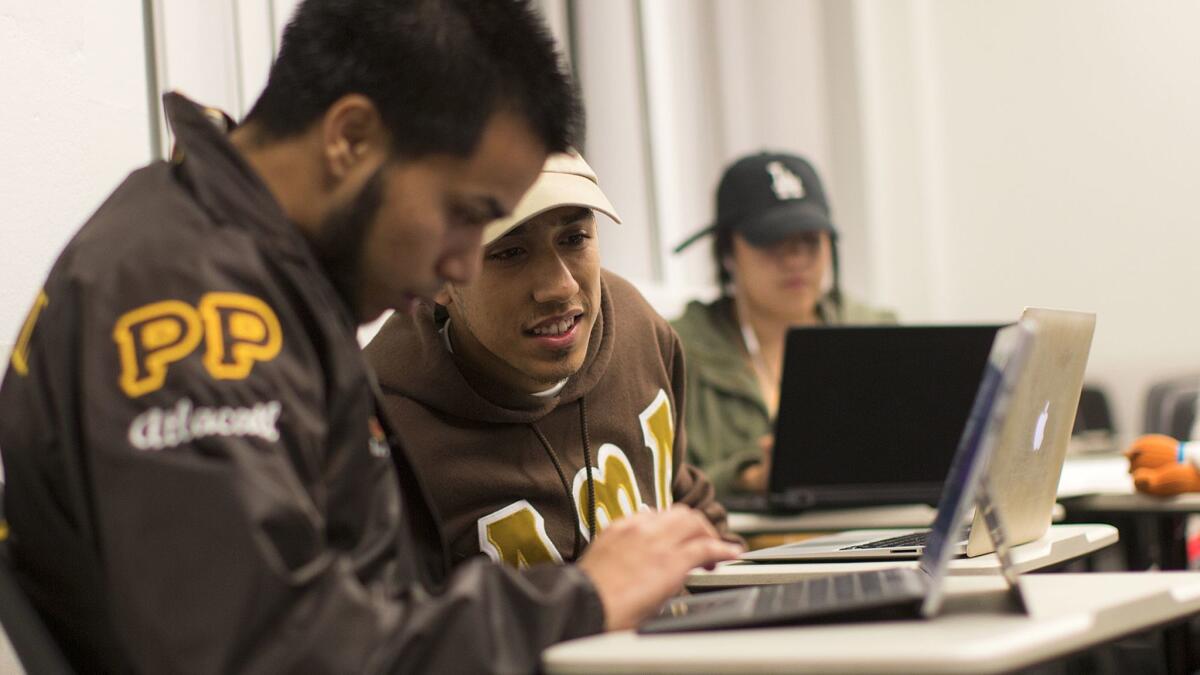
USC has been accepting transfers for decades but began recruiting heavily from community colleges about 10 years ago. University President C.L. Max Nikias often cites a 2006 study that found that fewer than 1 in 1,000 students at the nation’s most selective private universities was a community college transfer.
While some schools hesitate to accept transfers out of fear that graduation rates will suffer, USC transfer students graduate at about the same rate as the rest of the student body. Out of the 8,800 transfer applications received last year, USC accepted 27% — compared with the 16.6% freshman admissions rate. Still, the average admitted transfer student’s GPA was 3.7, or A-minus honors.
“We had to make sure that the transfer students that we brought in were able to compete with these very good freshmen students,” said Bruce Grier, a 34-year USC employee who oversees transfer admissions and transferred to USC himself from Pasadena City College after serving in the Navy. “Our goal was always to make sure that the professor couldn’t tell who the transfer student was.”
That often requires more than academics. Many transfer students experience culture shock and arrive short on skills that those from more privileged backgrounds take for granted — such as how to write a resume for a summer job or get to know professors during office hours.
“My first semester, I was thrown into career fairs, people were talking about internships, and I was just trying to find my way to class,” said Jimmy Ko, who transferred as a junior from Santiago Canyon College into USC’s undergraduate business school.
Ko co-founded the newly formed USC transfers club and has hosted workshops full of advice as basic as check your email, join clubs and use classes not just to learn but also to network. He’s pointed his peers to the many campus resources offering help with writing and research.
But at first he was so busy just getting his bearings, knowing he already had less time on campus than most classmates.
He didn’t find his groove enough to form the club until the end of his junior year, which made graduating feel bittersweet since there was so much more he wanted to do to create a community for the many transfers still navigating their USC years alone.
A transfer’s shorter stay on campus can seem shorter still given how long it can take to acclimate.
“It took me a year to feel like I belonged, and it was not easy,” said Adrian Trinidad, who transferred from Los Angeles Trade-Technical College in 2013.
In one of his first classes, on immigration in America, he said, he was one of a handful of Latino students in a class of 150. The professor asked how many students had nannies growing up, and a lot of hands went up.
“Right from the get-go, on the first day, I realized, ‘Wow, this is a different community than L.A. Trade-Tech,’” Trinidad said.
Still, he appreciated the opportunity he’d been given. He was near home, close enough to continue living there to help his father, who was disabled, and his mom, who works in a factory putting tags on shirts. He’d saved money going to community college first, then attending USC for two years on a full scholarship.
Now he’s working toward a doctorate in education at USC, studying how to make the transfer process more accessible for those with different backgrounds. He often visits Trade-Tech to answer students’ questions.
USC, he said, is so perfectly positioned to be a transfer hub, right in the middle of the Los Angeles Community College District. It also has a bigger role to play these days as overcrowded public universities are turning away qualified students.
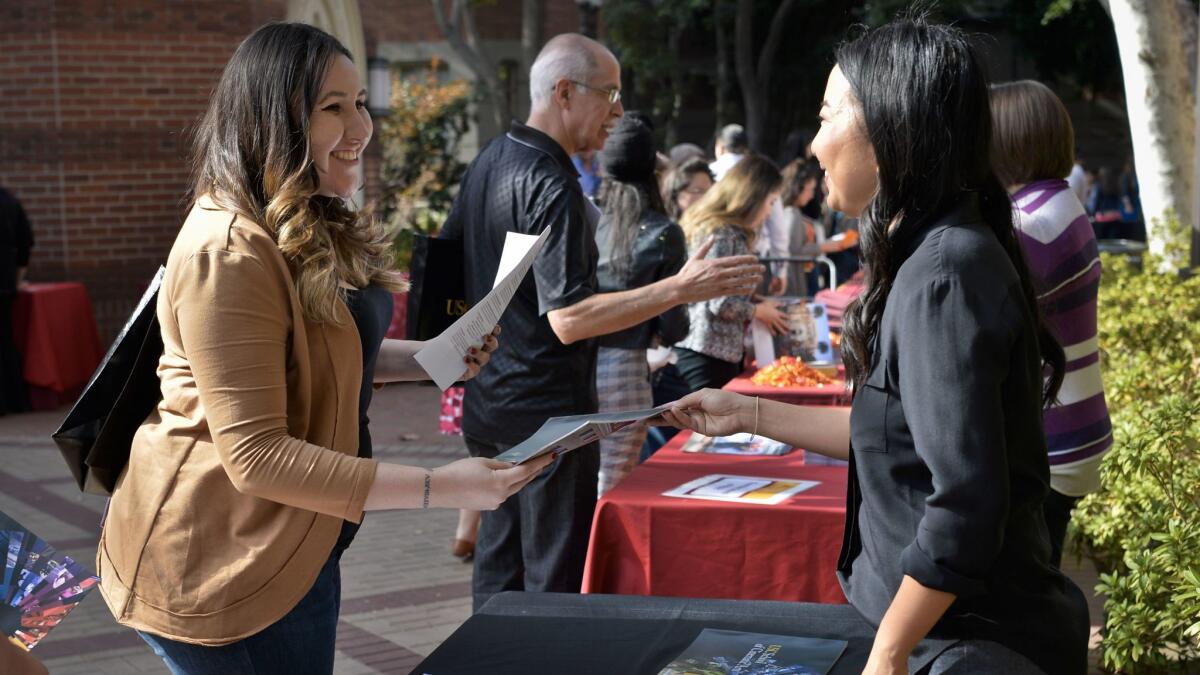
Hector Aguilar, who for 30 years has been a counselor at Los Angeles City College, said he’s seen USC in recent years become much more responsive to the students in its surrounding community.
One morning last fall, Aguilar joined dozens of other community college counselors at an annual conference held by USC’s admissions office.
Timothy Brunold, dean of admissions, had stigmas to address. He told them people often ask why USC didn’t just accept more freshmen straight from high school and whether the high transfer numbers were about making the university look more selective by letting fewer freshmen in.
“The reason that we don’t accept more freshmen is if we did so, we wouldn’t have room for the numbers of transfer students that we accept,” he said. “We can’t imagine building an institution, a cohort of students at this university, without having transfer students as part of that mix.”
Walking around campus later, Aguilar said the outreach is paying off.
“Students didn’t used to even ask me about actually coming here,” he said. “And now they are.”
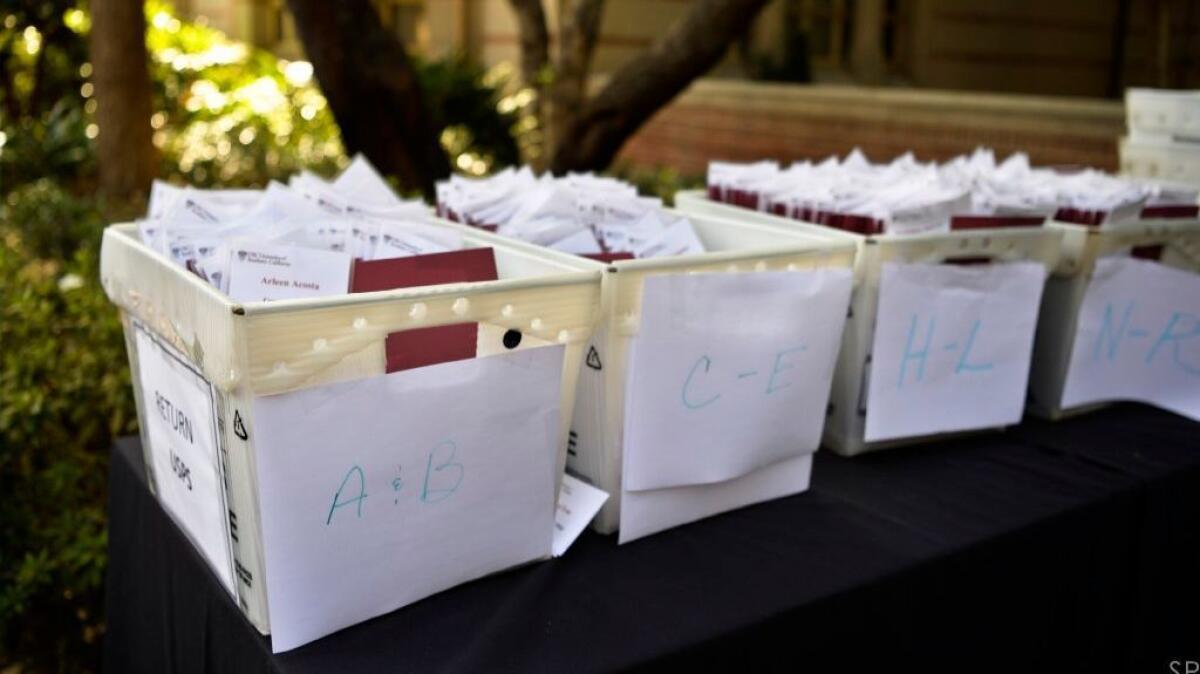
As for Garcia, who came from Sacramento, he’s now got a year under his belt along with new friends and new study habits.
One night before finals, he lugged coffee and stacks of pizza boxes into a classroom for a study night he’d organized with a friend who’d recruited him to be the second member of a Latino fraternity. He proudly wore his new La Unidad Latina, Lambda Upsilon Lambda sweatshirt as he greeted classmates from other multicultural student groups.
In a year, he’s switched majors three times. He’s now focused on health disparities in low-income communities. He’s tackled organic chemistry, become a board member of a new pre-med club for minorities and helped high school and community college students back home prepare for four-year college. With the help of a scholarship, he’s going on a research trip to Guatemala this summer.
He often studies at the library until 3 a.m. The reality of it all would hit him, he said, as he walked back to his dorm by the light of the campus street lamps.
“Once in a while, I’m just like, ‘Man, I go here,’” he said. “I see the trees and the buildings and how fancy they are, and yeah, I actually go here.”
To read the article in Spanish, click here
Follow @RosannaXia for more education news
ALSO
Fresno sixth-grader spells ‘marocain’ to become surprise winner of Scripps National Spelling Bee
New report says California is flunking out in producing enough educated adults for the workforce
What charter school supporters say they hope to change after school board victories
More to Read
Sign up for Essential California
The most important California stories and recommendations in your inbox every morning.
You may occasionally receive promotional content from the Los Angeles Times.











